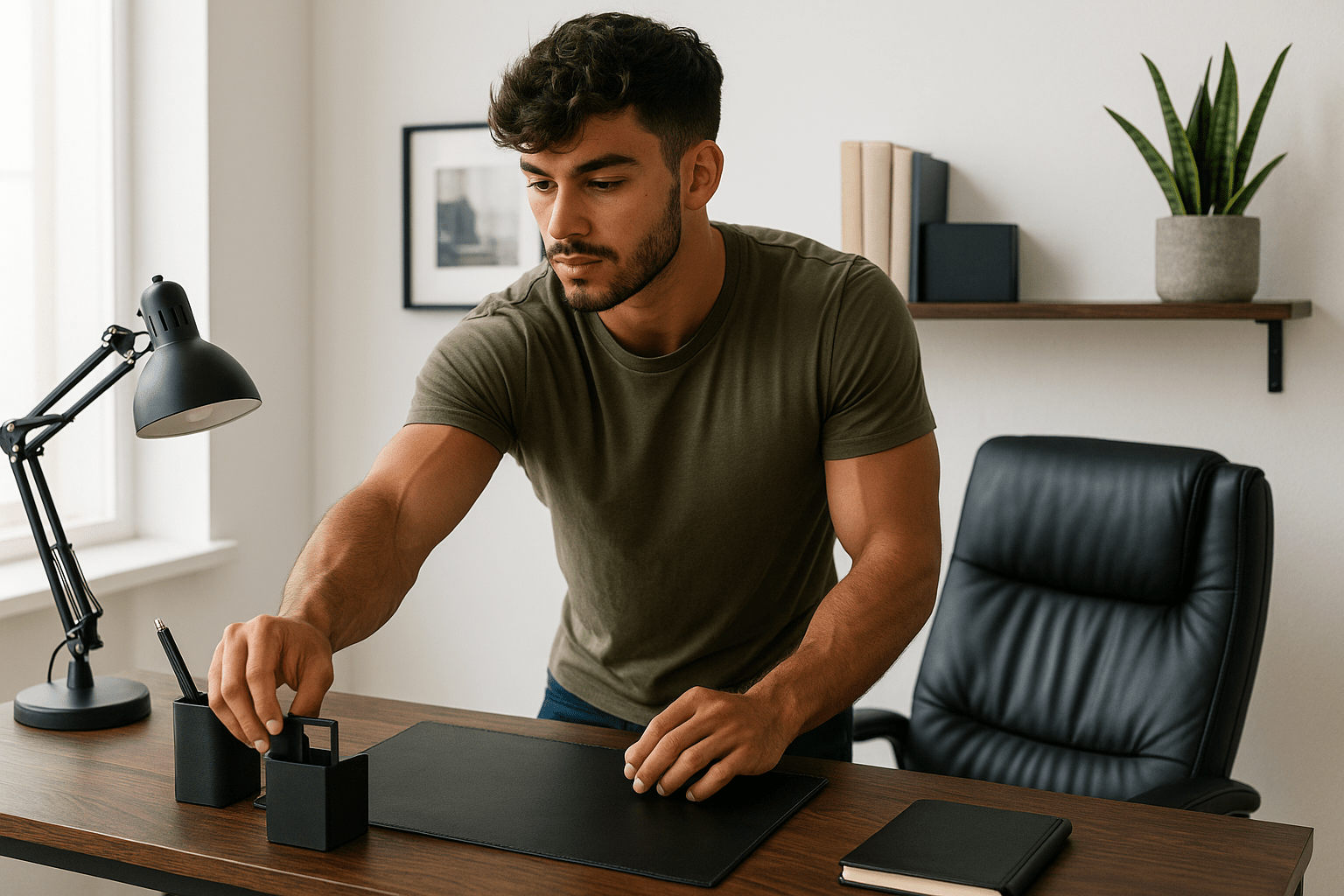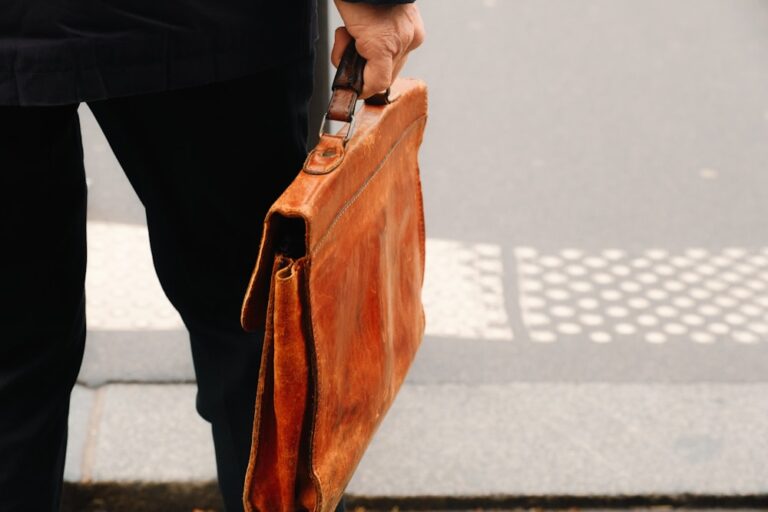
Elegance in Rebellion.
Own the Edge.
How to Turn a Small Office Into a Bold, Masculine Workspace

Walk into a small office and you can usually tell what kind of person runs it. Some spaces feel temporary, like they were thrown together in a hurry — a cheap desk, random chair, maybe a pile of tangled wires in the corner. Other offices, though, even if they’re small, have a presence. They feel sharp, intentional, and quietly commanding. That’s the kind of workspace you want. A bold, masculine office doesn’t need to be massive; it needs to be well-crafted.
A small office comes with challenges. You don’t have the luxury of excess. Every choice matters — the desk you pick, the chair you sit on, the color of the walls, even the way light hits your face during a video call. Masculine style works especially well in this setting because it’s not about clutter or trend-chasing. It’s about strength, focus, and simplicity that doesn’t feel bare but instead feels powerful.
The Foundation: Why Small Offices Need Masculine Precision
A masculine workspace thrives on clarity. Think of it as designing a personal command center. You’re building a room that tells your mind, “this is where things get done.” In smaller offices, distractions multiply quickly. A stack of papers, too many gadgets, or a chair that squeaks can ruin your flow. The masculine approach is about stripping out the noise and keeping what truly matters.
The first step is to respect the square footage. Instead of fighting the size of the room, lean into it. A small space designed with confidence feels more personal and exclusive than a big office filled with empty corners. Minimal furniture, intentional storage, and a clear color palette are what make a small office punch above its weight.
Colors That Work in Tight Spaces
Color sets the tone before furniture even enters the room. Masculine palettes are grounded in darker, natural shades — charcoal gray, olive green, deep navy, espresso brown, and black accents. But if you use too much darkness in a tight room, it can suffocate. The key is balance.
- Walls: Keep them clean and muted. A matte gray wall behind your desk, with the other walls kept in an off-white, keeps the space sharp but not overwhelming.
- Accents: A single wall in dark green or a black floating shelf can break up the monotony without shrinking the room visually.
- Materials: Wood grain, leather, and steel bring natural masculinity without decoration overload.
Real-world example: In a 9×10 office I worked from last year, the desk wall was painted slate gray. The desk itself was walnut, paired with a black leather chair. The rest of the walls were off-white, and a single industrial-style floor lamp brought warmth. Even though the space was small, it never felt cramped because the palette created depth.
The Desk: More Than Just a Table
In a small office, the desk isn’t just furniture. It’s the anchor of the entire room. Go cheap here and the whole setup feels temporary. Invest in the right desk and suddenly the room looks built with intent.
The right desk for a masculine office should be sturdy, minimal, and free from gimmicks. No shiny glass tops, no flimsy metal frames. A solid wood surface with strong legs sets the tone. If space is tight, go for a clean rectangular shape that fits flush against the wall. Avoid L-shaped desks unless your office is wide enough — they can eat up valuable walking space.
Why it’s needed: The desk is where your work habits form. A deep, wide-enough surface lets you spread out a laptop, notepad, and maybe a second monitor without feeling crowded. Clutter kills focus; the right desk helps prevent it.
Who should use it: Anyone serious about turning a small office into more than a storage room. Even freelancers or remote workers who only need a laptop benefit from a proper desk — it elevates your posture and mindset.
One desk I keep coming back to is the solid walnut writing desk we tested last year. Clean lines, no drawers to bulk it up, just raw functionality and beauty. When paired with black steel legs, it looked strong, worked in both modern and classic settings, and instantly gave the office authority.
The Chair: The Throne of Your Office
If the desk is the anchor, the chair is the throne. In a small office, you might only have one chair, so it better be the right one. A squeaky, fabric-covered, discount store chair will ruin the vibe instantly. Masculine style demands something that feels like it was made for long hours and serious work.
Leather is the natural choice. It’s timeless, durable, and it develops character the more you use it. A black leather executive chair with a steel frame not only supports your back but also adds visual weight to the room. You sit in it and you feel planted.
Why it’s needed: Comfort and longevity. If you’re working from home or pulling long hours, your chair directly affects your energy. Poor support leads to fatigue; strong support keeps you locked in.
Who should use it: Anyone who spends more than two hours a day at their desk. Students, remote workers, entrepreneurs — your chair is the one investment that directly pays you back every day.
A real-world example: In a friend’s 8×8 converted study, he swapped a cheap mesh chair for a vintage brown leather swivel chair. It instantly transformed the space. The chair’s presence made the tiny office feel like a gentleman’s library, even though nothing else in the room changed.
Lighting: Mood and Function in One
Lighting is one of the most overlooked elements in office design, especially in small spaces. Overhead fluorescent lights flatten everything and kill atmosphere. Masculine lighting is layered: a main light source for general visibility, plus targeted lighting for focus.
- Desk Lamp: A matte black swing-arm lamp is both functional and sharp. It keeps your immediate workspace lit without blasting the whole room.
- Floor Lamp: If space allows, an industrial-style floor lamp in the corner adds warmth and presence.
- Overhead Lighting: Keep it simple. A matte fixture or recessed lights prevent distraction.
Why it’s needed: Lighting controls the energy of the room. Dim it down and you’ve got a late-night focus zone. Brighten it up and you’re ready for video calls or paperwork.
Who should use it: Anyone working long hours, especially in offices without much natural light.
I personally use the matte black industrial desk lamp we brought into our studio last winter. Its pivoting arm and heavy base made it perfect for a compact desk, and the warm bulb softened the whole vibe of the office.
Storage: Control the Clutter
A small office doesn’t forgive clutter. Papers pile up, cables twist together, and before you know it, the room feels like a dump site. Masculine storage is simple: keep it hidden, keep it clean.
- Floating shelves instead of bulky cabinets.
- A minimal filing cabinet in black or wood finish.
- Cable trays and leather cord wraps to hide the mess under your desk.
Why it’s needed: Clutter kills productivity. A masculine office thrives on order.
Who should use it: Anyone with even moderate paperwork or gadgets.
One of the smartest upgrades we tested was the steel-frame floating shelf unit. It hugged the wall, carried everything from books to headphones, and freed up floor space. The office instantly felt bigger.
Accessories That Matter (and the Ones That Don’t)
In small spaces, accessories can make or break the vibe. Too many, and the office looks cluttered. Too few, and it feels bare. The masculine approach is to keep only what adds weight or meaning.
- A heavy-duty clock on the wall.
- A single framed black-and-white photograph.
- A leather desk pad to protect and define the desk surface.
- A set of matte black metal pen holders — functional, sharp, and clean.
Why they’re needed: Accessories in a masculine office are more than decoration; they’re markers of precision.
Who should use them: Anyone who wants their space to reflect discipline and taste.
What not to do: Don’t scatter little figurines, trinkets, or bright-colored gadgets. They eat up attention and cheapen the room.
Tech Setup: Hidden, Not Flashy
A masculine small office embraces technology but doesn’t let it dominate. Hide the wires. Mount the monitor. Keep the keyboard clean. Even with a gaming-level rig, if cables are spilling everywhere, the setup looks weak.
- Wireless mechanical keyboard in black: functional, tactile, and sleek.
- Noise-cancelling over-ear headphones: they double as decor when hung on a wall hook.
- Cable management sleeve: not exciting, but essential.
Real-world example: In a 10×12 home office I helped redesign, the client had three monitors and a desktop tower. By mounting the monitors on a single black arm and hiding the tower inside a ventilated cabinet, the whole room looked instantly larger. The technology was still there, but it didn’t scream for attention.
Personal Touch Without Losing Masculinity
Every office needs some individuality. The trick is to add personality without breaking the masculine vibe.
- A framed vintage poster instead of generic artwork.
- A cigar box used as storage.
- A military-style trunk repurposed as a side table.
- A single plant — but make it tough, like a snake plant or cactus, not a delicate fern.
One of my favorite touches is the minimal leather catch-all tray on the desk. It held keys, watch, and wallet during the day. Not only practical, but it also became a small ritual: empty pockets, sit down, get to work.
Common Mistakes to Avoid
- Overcrowding the room with oversized desks or chairs. Scale is everything in a small office.
- Using too many colors. Stick to a disciplined palette.
- Poor lighting choices. White LED bulbs can make the room feel like a hospital.
- Cheap finishes. In small offices, every detail is visible. Better to have fewer pieces of higher quality.
Who Benefits From a Bold Small Office
- Remote workers who need a space that keeps them sharp.
- Students who want a study room that feels motivating, not temporary.
- Entrepreneurs building from home but wanting an office that reflects ambition.
- Executives who may already have a large corporate office but want a smaller, private study that feels personal.
Pulling It All Together
Turning a small office into a masculine workspace isn’t about square footage. It’s about intent. Start with a strong desk, a supportive chair, disciplined colors, and sharp lighting. Layer in storage, accessories, and personal touches that actually matter. Keep clutter hidden, wires tucked away, and only bring in items that feel like they belong.
The result? A space that feels like a command center — compact but commanding, minimal but powerful.
Quick Reference: Masculine Small Office Essentials
| Element | Why It’s Needed | Best Material / Style | Real-World Example |
|---|---|---|---|
| Desk | Anchor of the room, sets tone and work habits | Solid wood (walnut, oak) with steel legs, minimal design | Solid walnut writing desk with black steel legs used in our studio |
| Chair | Comfort, posture, long-hour support | Leather (black or brown), steel frame, executive or vintage style | Vintage brown leather swivel chair that transformed an 8×8 office |
| Lighting | Controls energy and focus, prevents fatigue | Matte black desk lamp, warm bulbs, industrial floor lamp | Matte black industrial desk lamp tested in our winter setup |
| Storage | Keeps clutter hidden, makes small space feel bigger | Floating shelves, slim filing cabinets, steel-frame units | Steel-frame floating shelf unit that freed floor space instantly |
| Accessories | Adds discipline and personality without clutter | Leather desk pad, black-and-white framed photo, matte pen holders | Matte black metal pen holders paired with leather desk pad |
| Tech Setup | Productivity boost without visual chaos | Wireless black keyboard, cable sleeves, monitor arm | Mounted monitors on black arm to reclaim desk space |
| Personal Touch | Creates identity and ritual in workspace | Vintage poster, cigar box storage, snake plant | Leather catch-all tray used for keys, wallet, and watch |






